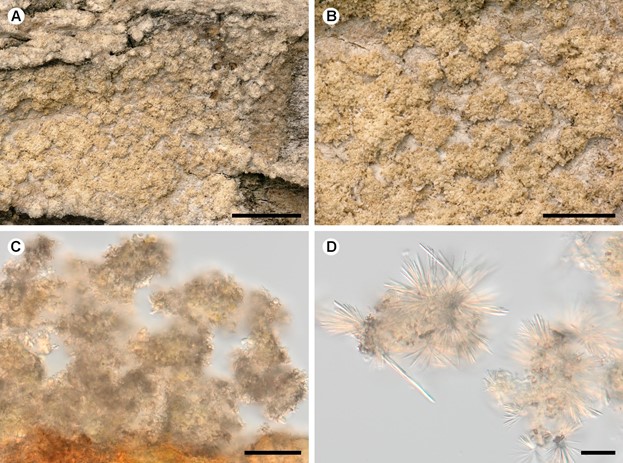Serusiauxia inexpectata Ertz & Diederich, sp. nov.(Figs 15–16)
MycoBank number: MB 834932; Index Fungorum number: IF 834932; Facesoffungi number: FoF;
Diagnosis: Distinguished from all known Pyrenulaceae species by a sorediate thallus and chemistry with gyrophoric acid (C+ red soralia).
Type: Mauritius, Pamplemousses district, Pamplemousses, Sir Seewoosagur Ramgoolam Botanical Garden, 20°06’21”S, 57°34’49”E, elev. 80 m, on bark of a ± vertical trunk of Terminalia, 29 Dec. 2016, Ertz 21490 (MAU – holotype, BR, herb. Diederich – isotypes).
Description. Thallus crustose, thin, rather inconspicuous, mostly endophloeodal, whitish to pale cream; prothallus brownish. Photobiont trentepohlioid, with cells 6–11 × 4–8 µm. Soralia numerous, dense, punctiform when young, erumpent, flat to slightly convex with loosely heaped soredia, mostly rounded, up to 0.6 mm diam, spreading and becoming confluent, sometimes almost forming a continuous leprose crust covering large areas of the thallus, pale creamish brown, rarely pale greyish-almost white. Soredia without projecting hyphae, 25–60 µm diam; hyphae 2–2.5 µm diam covered by tiny hyaline crystals dissolving in K (polarized light!); presence of calcium oxalate crystals mostly 0.5–4 µm diam, a few larger up to 12 µm diam (H2SO4 25% !). Ascomata and conidiomata unknown. Chemistry: thallus and soralia C+ red fleeting, K± pale yellowish (weak), P–, UV–, I–, KI–. TLC revealed gyrophoric acid in solvents B’ and EA (specimens Ertz 21490, 21496, Diederich 17815 and 18239 tested).
Ecology and distribution. The species is known from the Sir Seewoosagur Ramgoolam Botanical Garden and the Curepipe Botanic Gardens in Mauritius, where it grows on the bark of big trees, including Mangifera and Terminalia, and from the isle of Mahé in the Seychelles, where it has been collected in the ‘Jardin du Roi’ parkland.
Notes. The new species is most similar to Dendrographa decolorans (Arthoniomycetes), which differs by soralia with a mauve-grey to pale lilac-grey colour, different chemistry (unidentified fatty acids; thallus C–) (Wolseley & Hawksworth 2009), a non-tropical distribution (mainly in the Mediterranean and temperate regions) and a very different phylogenetic position (Arthoniomycetes, Roccellaceae) (Ertz & Tehler 2011). Sorediate morphs of Syncesia myrticola differ from the new species by a different chemistry (protocetraric acid; thallus PD+ rust-red) (Ertz et al. 2018a). Opegrapha fumosa also has a thin, inconspicuous thallus with C+ red soralia (gyrophoric acid), but the soralia are less dense, more irregular, often elliptical, and the species occurs only in temperate regions (Coppins et al. 1992).
Etymology. The epithet refers to the unexpected taxonomic position within the Pyrenulaceae, despite morphological similarities with some species of Arthoniales.
Additional specimens examined. MAURITIUS. Pamplemousses: Same locality as type, on bark of Mangifera, 2016, Ertz 21496; ibid., 2016, Diederich 18239. Plaines Wilhems: Curepipe, Curepipe Botanic Gardens, 2019, Diederich 19200. SEYCHELLES. Mahé: W of Anse Royale, Le Jardin du Roi, parkland, on a tree, 2015, Diederich 17815 (SEY, herb. Diederich).

Figure 15. Serusiauxia inexpectata [holotype]. A–B – thallus, showing soralia; C – soredia, in K; D – soredia, showing crystals formed after addition of H2SO4, revealing the presence of calcium oxalate crystals. Scales: A = 2.5 mm; B = 1 mm; C = 50 µm; D = 20 µm. Photos: D. Ertz.

Figure 16. Phylogeny of Pyrenulaceae based on a data set of mtSSU sequences that resulted from a RAxML analysis. Maximum likelihood boot- strap values are shown above or near internal branches. Internal branches that are considered strongly supported by both RAxML and Bayesian analyses are represented by thicker lines. The newly sequenced samples from Mauritius are highlighted, and their names followed by collecting numbers of authors, which act as specimen and sequence identifiers. A newly sequenced sample of Granulopyrenis from Iles Éparses is also added. The length of the branches represented by dashed lines was reduced by 50% for editing reasons.
